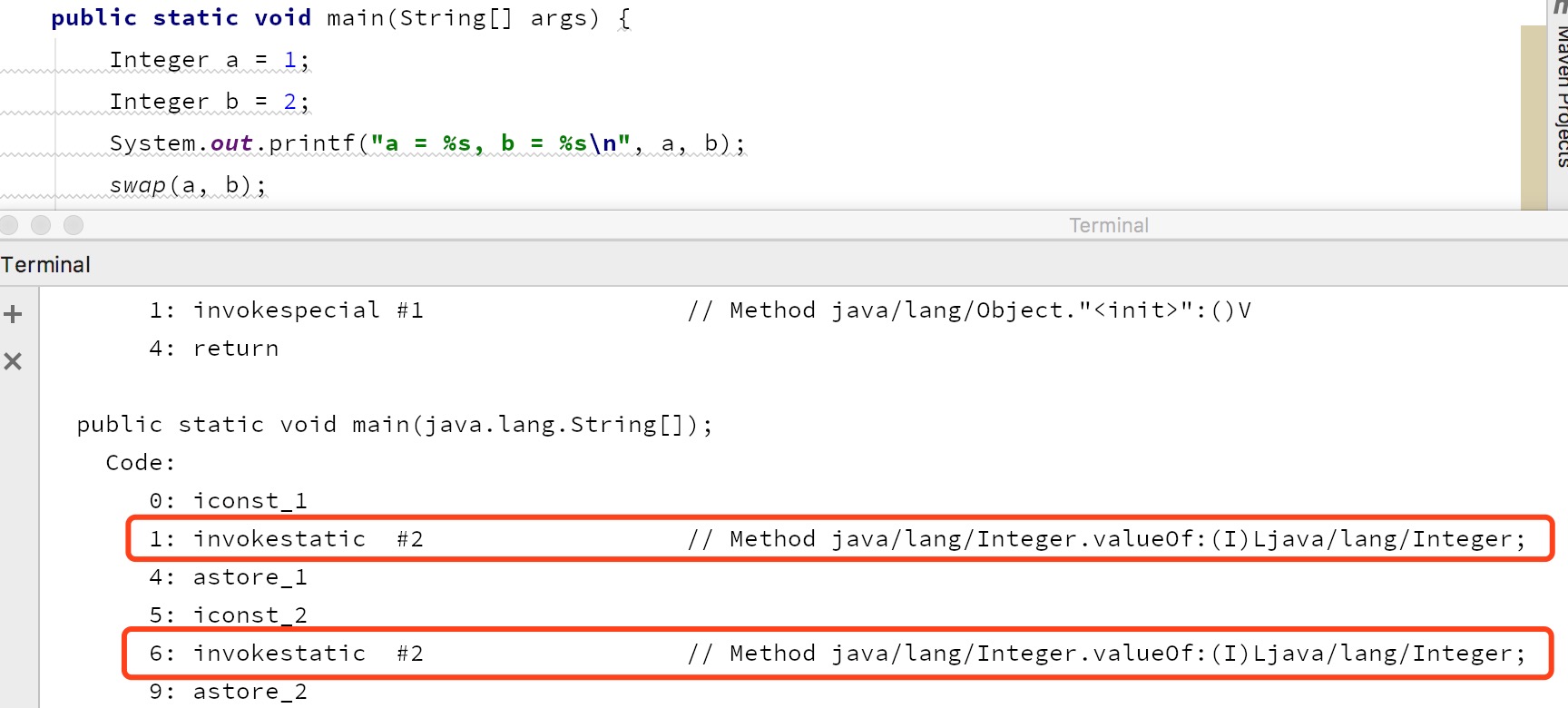简介
最近有点忙,很久没更新文章了,后面会慢慢恢复…回顾正题
最近看到一篇文章,关于一道面试题,先看一下题目,如下:
1 | public static void main(String[] args) { |
有人可能在没经过仔细考虑的情况下,给出以下的答案
1 | // 特别提醒,这是错误的方式 |
很遗憾,这是错误的。重要的事注释三遍
那么为什么错误,原因是什么?
想要搞清楚具体的原因,在这里你需要搞清楚以下几个概念,如果这个概念搞清楚了,你也不会把上面的实现方法写错
- 形参和实参
- 参数值传递
- 自动装箱
所以,上面的问题先放一边,先看一下这几个概念
形参和实参
什么是形参?什么是实参?概念上的东西,参考教科书或者google去吧,下面直接代码说明更加明显
1 | public void test() { |
注:为了清楚的表达意思,我命名的时候并没有按照java的驼峰规则命名,这里只是为了演示
通过上面的代码很清楚的表达形参和实参的概念,在调用testA时,传递的就是实参,而在testA方法签名中的参数为形参
从作用域上看,形参只会在方法内部生效,方法结束后,形参也会被释放掉,所以形参是不会影响方法外的
值传递和引用传递
值传递:传递的是实际值,像基本数据类型
引用传递:将对象的引用作为实参进行传递
java基本类型数据作为参数是值传递,对象类型是引用传递
实参是可以传递给形参的,但是形参却不能影响实参,所以,当进行值传递的情况下,改变的是形参的值,并没有改变实参,所以无论是引用传递还是值传递,只要更改的是形参本身,那么都无法影响到实参的。对于引用传递而言,不同的引用可以指向相同的地址,通过形参的引用地址,找到了实际对象分配的空间,然后进行更改就会对实参指向的对象产生影响
额,上面表述,可能有点绕,看代码
1 | // 仅仅是一个java对象 |
在main方法中,CODE_1中间的代码为声明了两个对象,分别设置value为1和2,而swap1和swap2两个方法的目的是为了交互这两个对象的value值
先思考一下,应该输出的结果是什么
…
…
1 | type1.value = 1, type2.value = 2 |
从输出结果来看swap1并没有达到目的,回头看一下swap1
1 | public static void swap1(IntType type1, IntType type2) { |
从值传递的角度来看,对象参数传递采用的是引用传递,那么type1和type2传递过来的是指向对象的引用,在方法内部,直接操作形参,交换了形参的内容,这样形参改变,都是并没有对实参产生任何影响,也没有改变对象实际的值,所以,结果是无法交换
而对于swap2,对象引用作为形参传递过来后,并没有对形参做任何的改变,而是直接操作了形参所指向的对象实际地址,那这样,无论是实参还是其他地方,只要是指向该对象的所有的引用地址对应的值都会改变
自动装箱
看我上面的那个例子的swap1,是不是顿时觉得与上面的面试题的错误做法非常相似了,是的,错误的原因是一模一样的,就是稍微有一点区别,就是Integer不是new出来的,而是自动装箱的一个对象,那么什么是自动装箱呢?jdk到底做了什么事?
如果你不想知道为什么,只想知道结果,那么我就直说,自动装箱就是jdk调用了Integer的valueOf(int)的方法,很简单,看源码
1 | public static Integer valueOf(int i) { |
上面那些如果不想深究可以忽略,就看最后一句,是不是明白了什么呢。没错,也是new出来一个对象,如果想知道上面的代码做了什么处理,可以参考 Long==Long有趣的现象 这篇文章,里面有介绍类似的
好了,有人可能会问,为什么会知道自动装箱调用的是valueOf方法,这里其他人怎么知道的我不清楚,我是通过查看反编译的字节码指令知道的
1 | public static void main(String[] args) { |
反编译出来的结果为

对比一下可以很清楚的看到valueOf(int)方法被调用
回归
好,现在回归正题了,直接操作形参无法改变实际值,而Integer又没有提供set方法,那是不是无解了呢?我很好奇如果有人以下这样写,面试官会有什么反应
1 | public static void swap(Integer a, Integer b) { |
既然出了肯定是有解的,可以实现,回头看看,在上面swap2的那个例子中是通过set方法来改变值的,那么Integer有没有提供呢?答案没有(我没找到)
那就先看看源码
1 | private final int value; |
这是Integer的构造函数,可以看到Integer对象实际值是用value属性来存储的,但是这个value是被final修饰的,没办法继续找,value没有提供任何的set方法。既然在万法皆不通的情况下,那就只能动用反射来解决问题
1 | public static void swap(Integer a, Integer b) { |
现在感觉很开心,终于找到解决方案,可是当你执行的时候,从输出结果你会发现,jdk在跟我开玩笑吗
1 | a = 1, b = 2 |
为什么会出现这种情况,无奈,调试会发现是在value.set的时候将Integer的缓存值改变了,因为value.set(Object v1, Object v2)两个参数都是对象类型,所以temp会进行自动装箱操作,会调用valueOf方法,这样会获取到错误的缓存值,所以,为了避免这种情况,就只能不需要调用缓存值,直接new Integer就可以跳过缓存,所以代码改成如下即可
1 | public static void swap(Integer a, Integer b) { |
至此,这道题完美结束
